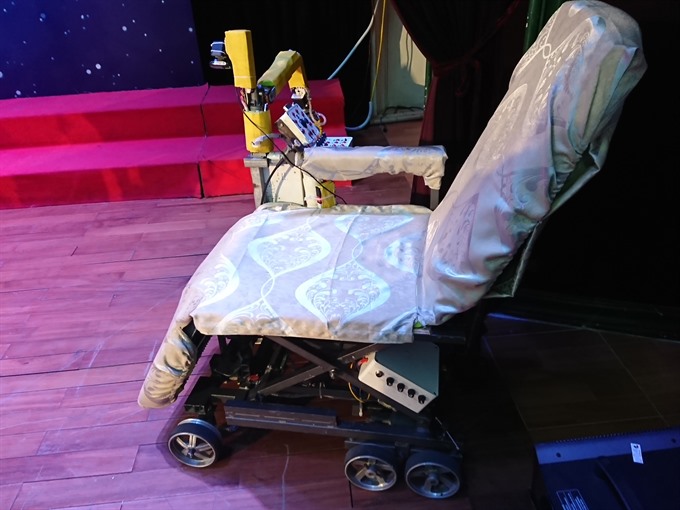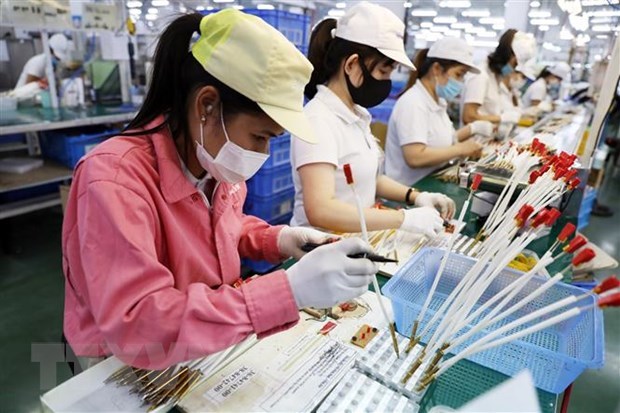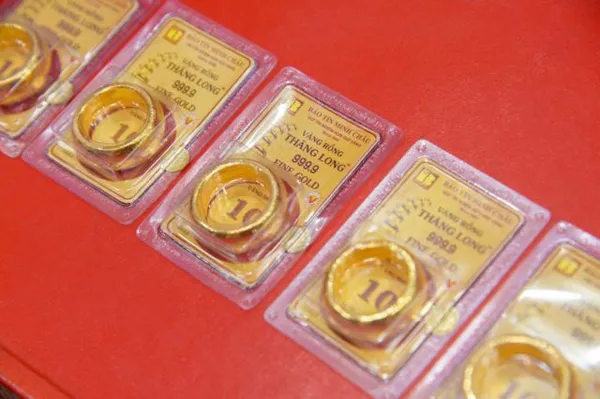

With a passion for physics, a Đồng Nai-based group of students have invented an affordable robot-wheelchair, in a bid to ease the struggle disabled people have with movements and maneuverers, having been inspired by the wheelchair used by world-renowned physicist Stephen Hawking.
 |
| Former Minister of Science and Technology Nguyễn Quân (right) presents the awards to the contest’s winner, the Đồng Nai students with their “Supporting robot for people with infirmities and disabilities.” – Photo courtesy of VMIG |
HÀ NỘI – With a passion for physics, a Đồng Nai-based group of students have invented an affordable robot-wheelchair, in a bid to ease the struggle disabled people have with movements and maneuverers, having been inspired by the wheelchair used by world-renowned physicist Stephen Hawking.
The three students from Đồng Nai Technology University in Đồng Nai Province also demonstrated on stage how their robot can double as a bed for the user to lay or sleep on. The robot can also lift or lower the user, within a certain level, so a user can easily move from the robot chair to his bed without assistance.
The chair is also outfitted with a robotic arm that can hold a water bottle or hand over clothing to users. The machine can either be manually controlled via a control panel or an app on a smartphone or tablet.
This thoughtful creation has deservedly earned the first prize worth VNĐ15 million (US$670) in the 2nd Việt Nam Maker Contest with Intel Galileo 2016 (VMIG), which came to an end last weekend.
The contest was jointly held by the Centre for Việt Nam Youth Talents, Science and Technology (CYTAST) and Intel Việt Nam, under the auspices and guidance of the Ministry of Science and Technology (MoST), Central Committee of the Hồ Chí Minh Communist Youth Union (HCM CYU), in a bid to promote the young generation’s creativity and spike their interests in science and technology – which ultimately is expected to contribute to the development of a high-tech economy in the nation.
 |
| The invention “Supporting robot for people with infirmities and disabilities” by Đồng Nai students. – VNS Photo Trọng Kiên |
The contestants made full use of Intel’s Edison platform – which, with the Intel Edison board at its core, aims at making it easier for hobbyists and inventors to develop consumer electronic devices, especially the Internet-of-Things devices, which is the current hot trend in the tech world.
In the six months beginning in June 2016, the nation-wide contest drew some 110 ideas from 29 universities and academies. Of these, 42 teams – each comprised of a maximum three students and one teacher for guidance – were selected to enter the preliminary round, in which they had three months, with one Intel Edison board and VNĐ2 million, to bring their ideas to reality.
Sixteen best creations from 14 universities were eligible to enter the final round.
The contestants’ inventions covered a wide range of fields, from education, health, agriculture, environment, transportation, and urban planning.
Nguyễn Anh Tuấn, Secretary of the Central Committee of the HCM CYU, said he was impressed by the “inventive spirits” of the young contestants.
“Aside from the creativity and passion to pursue their dreams, from these creations the contestants have exhibited a sense of responsibility for the development of the country. Importantly, you have shown care and compassion for the disadvantaged and vulnerable groups in society,” he said.
“And that’s a valuable quality because, after all, inventions have to be practical and bring benefits to society.”
The two second place prizes went to iGloves – a product from HCM City University of Science team, which can convert sign languages into Vietnamese speech, and a heat-vision camera from the Hà Nội University of Science and Technology team, which detects and gives warnings via smartphones about people with abnormally elevated body temperatures – which is often a tell-tale sign of sickness.
Other notable products include a pesticide-spraying robot, back massager shirt, a system that monitors working conditions, such as temperature and air quality for workers in factories, a system to provide users with bus routes and other information, and is able to give warnings when theft is detected. – VNS









